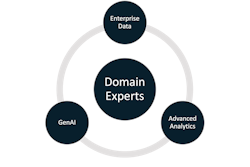The power of generative AI and advanced analytics
The emergence of generative artificial intelligence (GenAI) over the last two years ushered in new and exciting possibilities for industrial process analytics. This transformative technology, which generates new content such as text, code and images in response to user prompts, has the potential to reshape the way process manufacturers analyze data, optimize operations and make critical decisions.
Interest in GenAI comes at a time when process manufacturers feel exceptionally “data rich and information poor,” especially as the expansion of the Industrial Internet of Things (IIoT) increases the amount, complexity and accessibility of operational and equipment data. However, this surplus data yields tremendous opportunity when managed properly.
The simultaneous emergence of artificial intelligence (AI) and machine learning (ML) technologies offer the potential to uncover more meaningful insights. Yet, the journey from raw data to meaningful insight is still disjointed for many organizations.
As a result, there’s a need for software that empowers team members—including engineering, operations and management personnel—to achieve faster and more valuable insights from data, and to act on them more quickly to improve production and business metrics. Incorporating GenAI in advanced analytics software can impact the process industries because it makes it easier for domain experts to harness the software’s power, while increasing its effectiveness.
Increased power and capabilities
GenAI large-language models excel at understanding human input, as well as producing text and computer code quickly and efficiently, while advanced analytics solutions provide clear access to cleansed and contextualized time-series data. Combining these two technologies increases the power and capabilities of software solutions to recognize patterns, gather insights, make predictions and recommend actions.
To achieve the greatest success with this combination, the key ingredients—reliable enterprise data, advanced analytics and GenAI—must be combined in a workflow with domain experts at the core, not in the background (Figure 1).
Companies may experience many benefits by enriching advanced analytics with GenAI, including:
• Enhanced decision-making: By providing summaries and detailed explanations in natural language it’s easier for domain experts to understand the full process and make data-driven decisions with better accuracy. The result is an ability to analyze massive datasets to identify trends, anomalies and opportunities, and enable proactive decision-making.
• Higher analytics efficiency: It’s possible to quickly move from short text-based task descriptions to functional computer code that executes these tasks, often with only minimal tweaks and corrections. This empowers domain experts, such as engineers and data scientists, to focus on high-value activities, which reduces time-to-insight.
• More predictive power: GenAI increases the ability of algorithm-based analytical techniques to detect anomalies, inform predictive maintenance, and forecast production data. It also provides additional capabilities for pattern detection, particularly among datasets that represent a combination of sensor data with operational notes or logs.
• Simplified onboarding and training: GenAI can be used to power conversational and interactive user interfaces, making it easier for learners to master crafts in their manufacturing domains. With continuous connectivity to current knowledge bases, GenAI-based training also retains its relevance, enhancing training retention.
By providing streamlined access to modern technologies that make domain experts’ jobs easier, companies can not only redefine business operations, but also cultivate an inspired, engaged and empowered digital organization.
Limitations, risks and misconceptions
While GenAI promises the potential for significant improvements in the future, it’s essential for organizations to acknowledge its limitations and associated risks. These include data challenges, a lack of transparency and data privacy concerns.
GenAI models are typically trained using public datasets that represent common human knowledge, which are available on the Internet, but lack private knowledge. Due to the difficulty of removing inherent biases present in training data, this can potentially render some results inaccurate. Training models with domain-specific private data are onerous and technically difficult.
Complex GenAI models often function from the front end as a black box without interpretability, making it challenging to explain decision-making processes. Discretion must be employed by those using the models. When these models feed data to other software, there’s an added layer of complexity when placing filters on GenAI results to reduce the spread of false information, introducing risk of harm.
Data privacy and security concerns must be addressed when deploying GenAI in sensitive industries. Because GenAI platforms are open to the Internet for model training, developers and implementors must exercise caution to segment confidential information apart from public-facing components to avoid compromising data.
As media hype around GenAI continues to grow, organizations should also be wary of common misconceptions. Despite popular discourse, GenAI requires human oversight to function effectively. It doesn’t replace the need for domain experts, but instead, it complements their expertise.
Building an effective GenAI model requires a great deal of time and effort. It’s not a magic bullet for instant solutions. When deployed in the process industries, these models require fine-tuning and customization to meet specific needs. Off-the-shelf solutions may not yield optimal or even reasonable results.
Readiness and implementation
To assess readiness for augmenting data analysis of process systems with GenAI, organizations should examine three key attributes:
• Data quality: Evaluate the integrity and accessibility of process data. High-quality data is essential for GenAI effectiveness and relevance to the specific process problems being solved by the teams working on them.
• Skills expertise: Assess proficiency in data science and AI relevant to process industries. Determine whether staff have the skills to develop and maintain GenAI solutions, as well as an understanding of the processes and business teams the solutions are targeting.
• Infrastructure: Ensure necessary computational infrastructure and data storage capabilities are in place to support resource-intensive GenAI deployments.
Once these areas are considered, organizations should follow these guidelines for successful GenAI adoption and rollout:
• Invest in skills: Train the workforce in data science and AI, while developing in-house expertise to drive GenAI initiatives effectively.
• Define standards: Establish robust data governance practices to ensure data quality, privacy and compliance with industry regulations.
• Start small: Begin with pilot projects to test GenAI's applicability to the organization’s specific use cases before scaling up.
• Promote continuous learning: Foster a culture that pursues knowledge and adapt as GenAI technology evolves.
Unlocking GenAI’s potential
GenAI is poised to revolutionize the industrial approach to data analysis and decision-making. By combining GenAI with advanced analytics, process manufacturers can unlock new levels of efficiency, accuracy and innovation. Realizing the full potential of GenAI requires careful consideration of its limitations and risks, as well as a strategic approach to organizational readiness.
Process experts can harness GenAI's power by mindfully integrating these solutions into their workflows to drive favorable outcomes and stay ahead in an increasingly competitive landscape.
Dustin Johnson is CTO and founding partner at Seeq and is responsible for the advanced technology infrastructure, vision and roadmap of the company’s software solutions.
About the Author

Dustin Johnson
Seeq
Dustin Johnson the Chief Technology Officer at Seeq, responsible for the design and implementation of Seeq’s software products. He is a founding partner at Seeq and has played a critical role in growing Seeq’s product offering to meet the needs of Seeq’s ever-expanding and diverse customer base.

Leaders relevant to this article:

